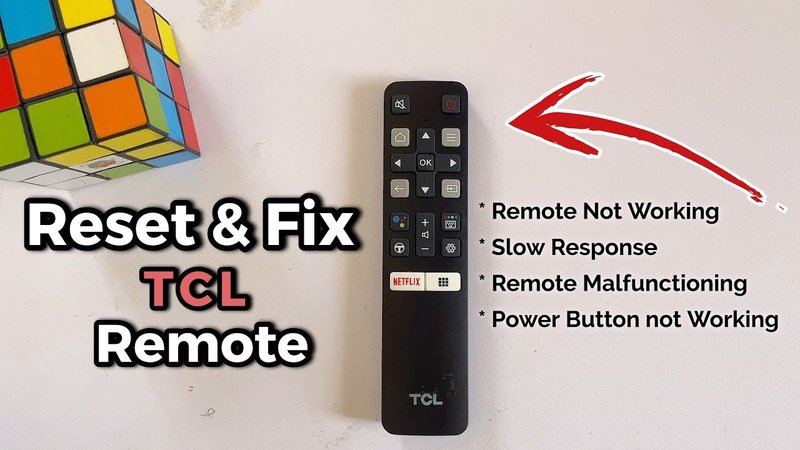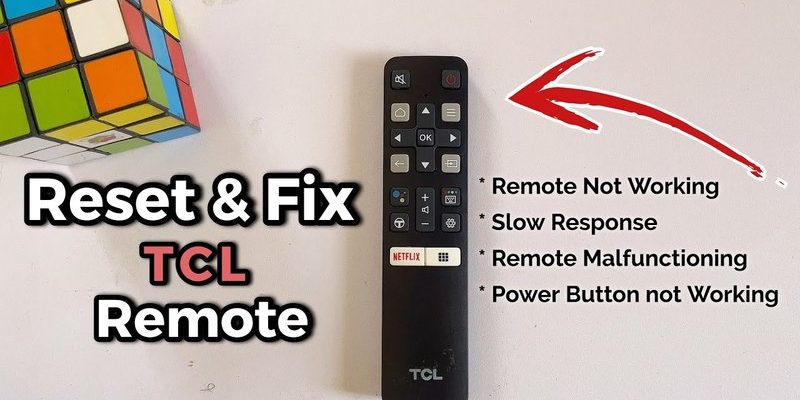
A lot of people don’t really think about their TV remote until it stops working. The thing is, TCL remotes (especially the ones that come with Roku-based models) are pretty common, and they get plenty of everyday abuse: being dropped, buried in couch cushions, or even chewed on by curious pets. There are a few simple tricks to reset, re-pair, or even refresh your TCL TV remote so it’s working like new. Stick with me—I promise it’s not as confusing as it sounds.
Understanding Your TCL TV Remote: Basic Types and How They Work
Not all TCL TV remotes are created equal—there are actually a few different types floating around. Some TCL TVs use traditional infrared (IR) remotes, which basically work by sending invisible light signals to a sensor on your TV. These are the classic “point-and-click” remotes; if something gets in the way, game over. Others (especially those bundled with TCL Roku TVs) use a slightly fancier Bluetooth or Wi-Fi direct technology. This means you don’t have to aim directly at the TV, which is a lifesaver if your dog likes to park himself right in front of the screen.
Honestly, before you try anything else, it helps to figure out which kind of TCL remote you’ve got. Why? Because the reset methods can be totally different. Flip your remote over: Does it have a pairing button inside the battery compartment? That usually means you’ve got one of the “smart” remotes. If not, and your remote looks like it belongs in the 90s, it’s probably IR.
Here’s the thing—knowing your remote’s style will save you from a lot of trial and error. If you’re not sure, check your TV’s model number (usually hiding on the back of the set) and Google it. That’ll tell you if you’re dealing with a standard TCL remote, a Roku remote, or a universal remote someone swapped in along the way.
Signs Your TCL TV Remote Needs a Reset
So, how do you know your remote needs a reset and not just a new pair of batteries? You might notice things like laggy button presses, the remote only working from certain angles, or a total lack of response even when you’re practically nose-to-nose with the TV.
Sometimes, it’s not even the remote’s fault—maybe you just spilled soda on it, or the dog drooled all over the power button (true story: my friend’s golden retriever once made the Netflix app play in slow motion for a week). But honestly, technology can be weird. If you’ve tried new batteries and wiped everything down and your remote is still acting like it’s got a mind of its own, it’s probably time for a reset.
You might be wondering, “Isn’t there just a reset button I can press?” If only it were that easy. Most TCL remotes don’t have a dedicated reset button, but they can still be reset using a series of steps (think of it like an old-school video game cheat code). Spoiler: you’re definitely not alone if you’ve never tried this before.
Step-By-Step: How To Reset Your TCL TV Remote Control
Let’s get into the nitty-gritty. Resetting a TCL TV remote isn’t rocket science, but the exact steps depend on your remote type. Here’s a super clear breakdown for both IR and Roku-style TCL remotes.
For IR (infrared) TCL remotes:
- Pop open the battery cover and take out both batteries.
- Press and hold any button on the remote for about 20 seconds. (Why? It drains any leftover power and helps clear its memory.)
- Release the button, pop in fresh batteries, and close it back up.
- Try using the remote again—aim it straight at the TV sensor and press power or volume.
For TCL Roku TV remotes (with a pairing button):
- Remove the batteries from the remote.
- Unplug your TCL TV from the power outlet, wait a full minute, then plug it back in.
- When you see the TV’s home screen, reinstall the remote’s batteries. Hold down the pairing button (it’s usually in the battery compartment) until you see a flashing light on the remote.
- Wait for the TV to confirm pairing—usually, you’ll see something on the screen. The pairing may take up to 30 seconds. After that, you’re good to go.
If your remote doesn’t seem to pair or respond after these steps, don’t panic. Double-check that your batteries are good, and make sure nobody’s blocking the sensor on your TV.
What To Do If Resetting Doesn’t Fix Your TCL Remote
Alright, so you’ve followed all the “reset the TCL TV remote” instructions and… still nothing. Don’t freak out—remotes can be stubborn little things. But at this point, it’s smart to try a few more troubleshooting steps before declaring your remote officially haunted.
First, try a quick remote code check—if you’re using a universal remote with your TCL TV, you’ll need to make sure it’s programmed with the correct code. Most universal remotes have a list of codes printed in the manual or available online. If you lost the manual (like most people), just search for “TCL TV remote code” plus your remote’s brand online.
Next: batteries. I know it sounds basic, but sometimes new batteries aren’t as fresh as they look. Test a different pair, or use another remote’s batteries for a minute—just as an experiment. If it suddenly works, congrats! You’ve solved the mystery.
If you’re still out of luck, try a full TV power cycle. Unplug your TV, wait at least 60 seconds (yes, it matters), then plug it back in. Sometimes the TV itself just needs a “brain reset” to start recognizing remotes again. It’s a bit like turning your phone off and on when it freezes—surprisingly effective.
Comparing TCL Brand Remotes To Universal Remotes
Here’s where things get interesting. If you’ve got your original TCL remote, that’s usually the best match for your TV. They’re designed to speak the same “language,” so to speak. But universal remotes are a popular backup—especially when kids, pets, or clumsy adults (guilty!) lose or break the original.
Universal remotes can usually be programmed to work with TCL TVs, but there’s an extra step: syncing a remote code. Sometimes it’s smooth sailing; other times, you’ll be mashing buttons and consulting Google at midnight. If you’re using a universal remote, make sure you follow the pairing instructions carefully. Look for a “code search” or “pair” feature—these often involve holding down a specific button until the remote blinks, then entering a TCL TV code.
Honestly, universal remotes *can* be lifesavers, but they’re not always as seamless as brand-specific ones. If you have trouble with codes not syncing, try resetting both the remote and the TV. Patience pays off here, and you might just end up with a remote that does everything—except maybe make you coffee.
When To Replace Your TCL TV Remote Control
Sometimes, a remote is just too far gone. Maybe the buttons stick, the circuit board is fried, or your roommate dropped it in the bathtub (don’t ask). If you’ve tried every reset trick and swapping batteries didn’t help, it could be time to shop for a new TCL remote.
Replacement TCL TV remotes are surprisingly easy to find. You can buy official brand remotes online, or pick up a compatible third-party or universal model. Double-check the product listing for your exact TCL TV model before you hit “buy”—sometimes there are minor model differences that matter.
Pro tip: Hang onto your old remote for a few days after you get a new one. Sometimes remotes just need a break, and they’ll magically spring back to life once you’ve already upgraded!
Preventing Future TCL Remote Problems: Care, Storage, and Sync Tips
Here’s the part nobody really talks about—taking care of your remote so you (hopefully) won’t have to reset it all the time. The best preventative step? Treat your remote better than you treat your phone, because it’s easier to replace a phone case than to find a spare remote during a season finale.
- Keep your remote away from drinks, sinks, and anywhere spills are possible. (Trust me, a single juice spill can ruin movie night.)
- If you don’t use your TCL TV for a while, take the batteries out of the remote to stop corrosion.
- Don’t mash the buttons too hard. If something doesn’t work instantly, try resetting instead of going full Hulk.
- Store the remote somewhere you can always find it—TV trays, magnet holders, even zip ties if you’re desperate!
Syncing your remote every now and then (especially after a big software update) can also prevent random disconnects. If you get a new Wi-Fi router, or if the remote feels laggy, try the reset and re-pair steps we talked about earlier. Prevention really is easier than troubleshooting when your favorite show is starting.
Troubleshooting Weird Issues: When Things Get Complicated
Now and then, remotes get extra weird. Maybe the power button works, but the volume button doesn’t, or you can turn the TV on, but you can’t navigate the menu. This can be super frustrating, and sometimes it’s not even the remote’s fault—it could be a software bug, a bad sensor, or wireless interference.
Here’s what to do if your TCL TV remote acts possessed:
- Check for obstructions between the remote and TV sensor if you’re using IR—plants, picture frames, or even sun glare can mess it up.
- Make sure your TV isn’t stuck in a weird “demo mode.” Head to your settings menu and look for something called “Store Demo” or “Retail Mode.”
- Update your TV’s software. Go into the TV menu, hit “System,” then check for software updates. Sometimes, new firmware can fix remote bugs.
- If none of the buttons work, and you’ve done a reset, it might be worth calling TCL support before you throw in the towel.
At the end of the day, TCL TV remotes are usually reliable, and resets fix most problems. But if you keep running into weird glitches, it could be your TV’s receiver or a random software gremlin.
Wrap-Up: Getting Your TCL TV Remote Back On Track
Resetting a TCL TV remote control isn’t some mysterious tech ritual—it’s more like flipping the batteries and giving your old remote a pep talk. Even if you’re a total beginner, the steps are simple and forgiving. Whether you’re dealing with IR or a smart Roku-style remote, a quick reset or code re-sync can save the day (and your sanity). And if it’s really dead? Hey, sometimes a fresh start is all you need.
Keep those batteries fresh, keep the buttons clean, and don’t be afraid to experiment a little. With a little patience, you’ll be back to channel surfing in no time—no sorcery required.
